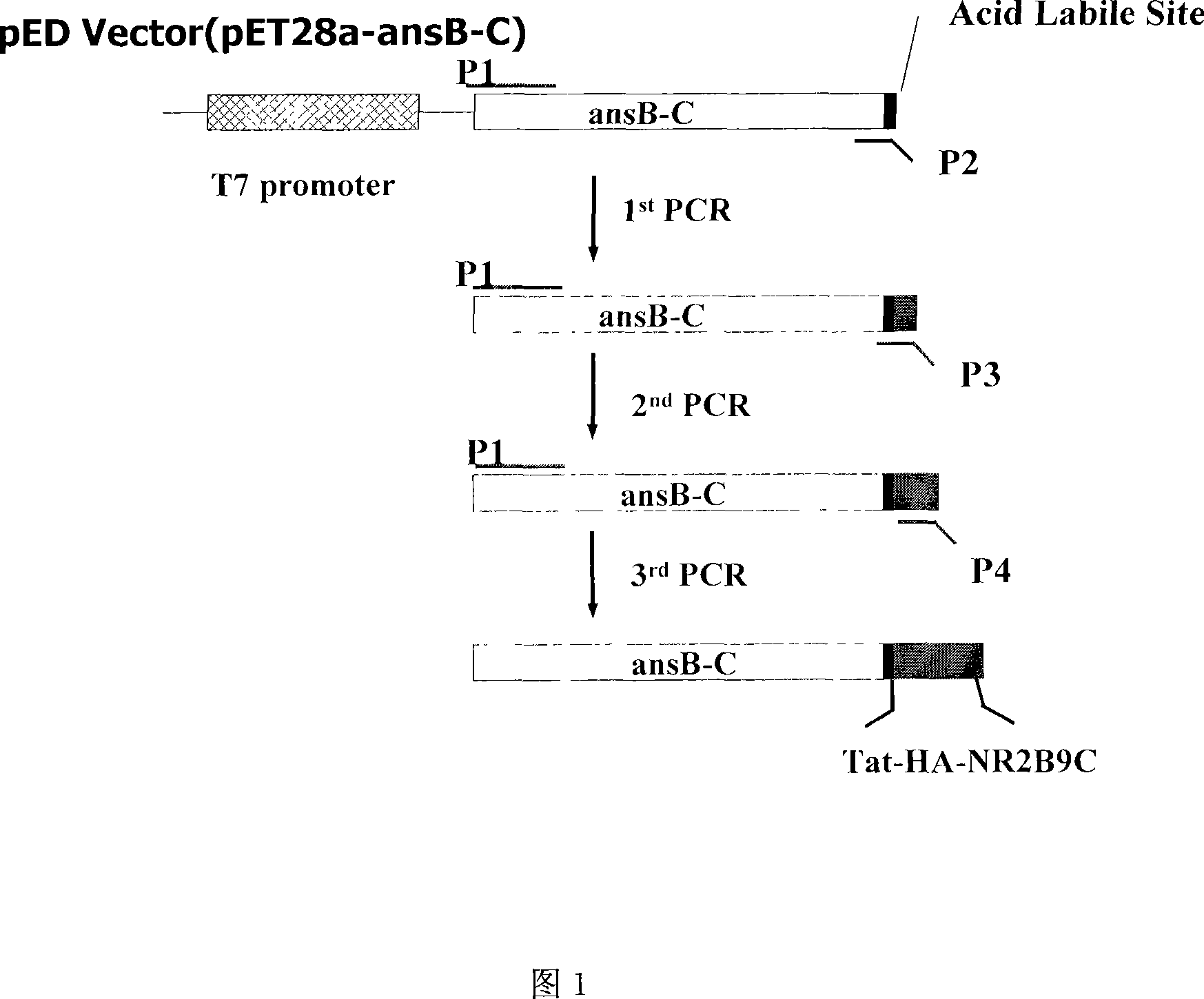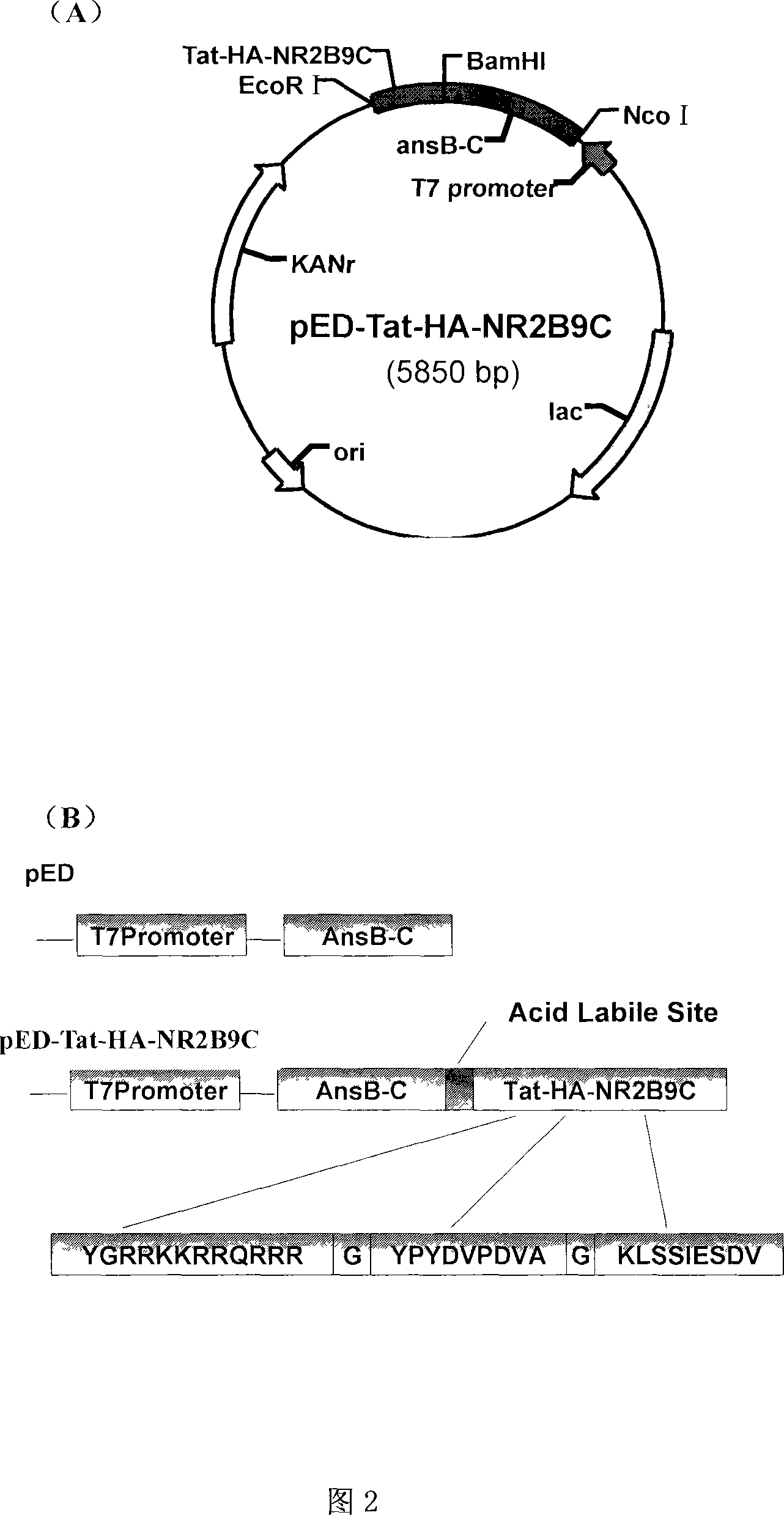Polypeptide analogue for blocking NR2B signal path and preparation method and medical usage thereof
A technology of analogs and fragments, which can be used in drug combinations, chemical instruments and methods, medical preparations containing active ingredients, etc., and can solve problems such as harmfulness and ineffectiveness of NMDA receptor antagonists.
- Summary
- Abstract
- Description
- Claims
- Application Information
AI Technical Summary
Problems solved by technology
Method used
Image
Examples
Embodiment 1
[0059] Design, Synthesis and Cloning of Tat-HA-NR2B9C Polypeptide Gene
[0060] According to the amino acid sequence of the Tat-HA-NR2B9C polypeptide gene, the codon preferred by Escherichia coli was selected, and the complete sequence of the Tat-HA-NR2B9CP polypeptide gene was designed with the aid of a computer. Based on the sequence, four oligonucleotide fragments were designed and chemically synthesized. Using the C-terminal of the L-ansB-C gene of pED as a template, the gene fragment containing the target peptide sequence, that is, the Tat-HA-NR2B9C polypeptide gene, was obtained by adding end PCR, and transformed into Escherichia coli Escherichiacoli BL21 (DE3). The extracted plasmid was named pED-Tat-HA-NR2B9C. The specific method is as follows:
[0061] The 4 oligonucleotides are as follows:
[0062] P1: 5′-TACCATGGATACGCCATTCG-3′
[0063]P2: 5′-CGGCGGCGCTGGCGGCGTTTTTTACGACCGTAACCCGGATCCGCGTACTGGTT-3′
[0064] P3: 5′-TACCAGCAACGTCCGGAACGTCGTACGGGTAACCGCGGCGGCGCTGG...
Embodiment 2
[0069] Improvement of LB medium and formulation of arginine enriched LB medium
[0070] The recombinant plasmid pED-Tat-HA-NR2B9C was transformed into Escherichia coli BL21. When the fusion protein was induced and expressed in ordinary LB medium, the expression level of the fusion protein was very low, as shown in Figure 4A, Lane5. In order to induce a large amount of expression of the fusion protein AnsB-C-Tat-HA-NR2B9C, a certain amount of Arg hydrochloride was added to the LB medium as a source of special amino acids. The strains were inoculated in the LB medium containing Kan (50 μg / ml) at a ratio of 2%, and the LB medium was supplemented with arginine according to the amount of 0, 0.1%, 0.5%, and 1% (W / V) respectively. After 4 hours of incubation at 37°C, the inducer lactose was added, and after 4 hours of induction, samples were taken for SDS-PAGE analysis. The results showed that when the content of arginine in the LB medium was 0.1% (W / V), the expression of the fusio...
Embodiment 3
[0078] Expression of Tat-HA-NR2B9C Polypeptide Gene in Escherichia coli
[0079] Pick a single colony from the plate and inoculate it into arginine-enriched-LB liquid medium, shake it overnight at 37°C, transfer it to a fresh liquid medium at a ratio of 2%, cultivate it at 37°C for 4 hours, add the final IPTG at a concentration of 0.1 mmol / L induced Escherichia coli to express T7 RNA polymerase, thereby expressing the fusion protein. Samples were taken at 1, 2, 3, and 4 hours after the addition of the inducer, and the results of SDS-PAGE electrophoresis showed that the expression of the fusion protein reached a peak and remained at a stable level after the addition of the inducer 3 hours, and there was no increase with the induction time. The changes were obvious, so the cells were collected around 3.5 hours after induction, and the results are shown in Figure 4B.
PUM
| Property | Measurement | Unit |
|---|---|---|
| Molecular weight | aaaaa | aaaaa |
Abstract
Description
Claims
Application Information
 Login to View More
Login to View More - R&D
- Intellectual Property
- Life Sciences
- Materials
- Tech Scout
- Unparalleled Data Quality
- Higher Quality Content
- 60% Fewer Hallucinations
Browse by: Latest US Patents, China's latest patents, Technical Efficacy Thesaurus, Application Domain, Technology Topic, Popular Technical Reports.
© 2025 PatSnap. All rights reserved.Legal|Privacy policy|Modern Slavery Act Transparency Statement|Sitemap|About US| Contact US: help@patsnap.com



